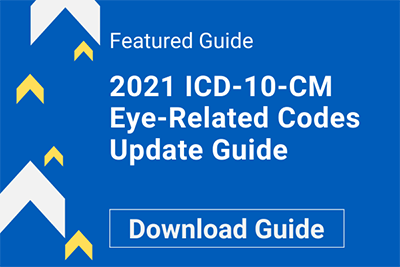
24 Aug ICD-10-CM Codes Guide: 2021 Updates for Eye Care
Do you know what ICD-10-CM eye-related diagnosis codes were added, deleted, or modified for fiscal year 2021? Is your ophthalmology and optometry practice management software ready for 2021 ICD-10 updates?
This year marks the fifth update to ICD-10-CM codes since ICD-10 codes went live on October 1, 2015. Beginning October 1, 2020, all eye care providers must start using the new and revised ICD-10-CM codes to avoid delays in claim processing and/or rejected or denied claims later.
Download our 2021 ICD-10-CM Codes Update Guide to start educating coders, billers, and providers now.
What is an ICD-10-CM Diagnosis Code?
The ICD-10-CM diagnosis code is a medical code that describes the condition and diagnoses of patients, whereas the ICD-10-PCS code describes inpatient procedures. A diagnosis code tells the insurance payer why you performed the service.
The World Health Organization (WHO) owns, develops, and distributes ICD codes. In the US, these are divided into ICD-10-CM, or Clinical Modifications, and ICD-10-PCS, or Procedure Coding System. Each year, the Centers for Medicare & Medicaid Services (CMS) and the Centers for Disease Control and Prevention (CDC) National Center for Health Statistics (NCHS) publish new, deleted, and modified ICD-10-CM codes.
The ICD-10-CM code release for fiscal year 2021 includes 72,616 diagnosis codes as compared to 72,184 in 2020.
Six Tasks to Stay Ahead With 2021 ICD-10-CM Code Updates
To prevent unhealthy and serious revenue problems in your practice, here are six critical billing pro tips to help you prepare for the 2021 ICD-10-CM code updates.
- Review and become familiar with the new, deleted, and revised ophthalmology and optometry billing codes (download our 2021 ICD-10-CM Codes Guide). Claims that have a service date of September 30, 2020, or earlier, must continue to use the current 2020 codes, while claims with a service date of October 1, 2020, or later, must use the new 2021 codes.
- If you have a “favorites” list in your EHR and practice management system, add new codes and remove old codes.
- Review plans, assessments, and outbound documents in your optometric software, and map old codes to the new codes.
- Review and update all “code rules” you created in your EHR and practice management software that need to change from the new and deleted 2021 codes.
- Be careful when using “copy from previous” as many ophthalmology and optometry software systems copy over removed codes. Ensure the primary ICD-10-CM codes match the primary chief complaint and reason for the visit to the exam note.
- Contact your optometry (American Optometric Association) and ophthalmology (American Academy of Ophthalmology) associations for specific coding changes and ICD-10 coding resources.
What Changed in 2021 for ICD-10-CM Codes?
For the 2021 fiscal year, there are 490 new, 58 deleted, and 47 revised ICD-10-CM codes. Of these codes, there are 72 code changes for eye-related discharges and patient encounters occurring from October 1, 2020, through September 30, 2021: 53 new and 14 deleted codes, and 5 revised code descriptions.
ICD-10-CM codes are divided into 22 chapters, and codes are based on code subjects. Chapter 22 (Codes for Special Purposes, U00-U85) is new this year and only includes two codes: vaping-related disorder (U07.0) and COVID-19 (U07.1).
The 2021 eye-related code updates primarily affect the following four ICD-10-CM chapters.
- Chapter 7: Diseases of the eye and adnexa (H00–H59). The new corneal dystrophies and dystrophy codes add one digit to the end of the codes to specify laterality and represent the patient’s condition more accurately. A new code for deficient smooth pursuit eye movements has been added (H55.82), and “deficient” was added to saccadic eye movements (H55.81).
- Chapter 18: Symptoms, signs and abnormal clinical and laboratory findings, not elsewhere classified (R00–R99). The new codes add one digit to the end for specificity to code the symptom of the headache.
- Chapter 19: Injury, poisoning and certain other consequences of external causes (S00–F88). The new codes add one digit to specify laterality that describes corneal transplant rejection, failure, infection, or complications.
- Chapter 20: External causes of morbidity (V00–Y99). The new codes add one digit to the end of the code for specificity for therapeutic (nonsurgical) and rehabilitative ophthalmic devices associated with adverse incidents.
ICD-10 Pro Tip: Before you use an “unspecified” code (primarily when it refers to laterality), the examining provider must indicate the affected anatomy.
Related: 2022 ICD-10-CM Codes Update Guide for Eye Care
Embedded ICD-10 Tool in Optometry Software Simplifies ICD-10 Code Updates
Your ophthalmology and optometry practice management and EHR systems should provide automatic ICD-10 updates. On October 1, 2020, MaximEyes EHR and practice management software will automatically start using the new 2021 ICD-10-CM codes. Easily find and select ICD-10 codes with an intuitive ICD Code Selection Tool that automatically prompts you for coding modifiers if you forget any.
Stay in Control With This 2021 ICD-10-CM Codes Update Guide
Our 2021 ICD-10-CM Eye-Related Codes Update Guide includes a list of codes and descriptions for new (added), deleted (retired), and revised (modified descriptions) codes. We also added a list of ICD-10 industry resources to make the transition easier. Download the guide now.






